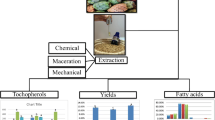Abstract
The sterol and wax content of solvent extracted (SEHO) and cold pressed hazelnut oils (CPHO) were compared. A total of 48 samples from 19 hazelnut varieties were collected for two successive crop years from four different geographical districts in Turkey. Hazelnuts were processed to oil with a laboratory scale press, than the remaining oil in cake was extracted with n-hexane. CPHO and SEHO were evaluated for their wax, sterol and squalene contents. Results showed that sterol, squalene and wax contents of all individual cultivars were higher in SEHO than those of CPHO, indicating the higher solubility of these compounds in solvent. Total sterol contents ranged between 1088.56 (Kargalak)—1609.39 mg/kg (Mincane) for CPHO and 1590.86 (Çakıldak)—2897.26 mg/kg (Mincane) for SEHO. Hazelnut oils were found to be richer of C36-38 esters than C40-46 group. Total wax content was between 24.19 (Kargalak)—94.58 mg/kg (Kuş) for CPHO and 81.46 (Kargalak)—160.92 mg/kg (Akçakoca) for SEHO. The squalene amounts of the samples obtained by hexane extraction were between 499.75 (Allahverdi)—885.36 mg/kg (Cavcava), while it varied between 288.55 (Kargalak)—647.68 mg/kg (Mincane) in cold pressed oils. Significant and obvious variations between SEHO and CPHO were verified by principal component and hierarchical cluster analysis. Geographical discrimination was also achieved by discriminant analysis.






Similar content being viewed by others
References
Willett WC, Sacks F, Trichopoulou A, Drescher G, Ferro-Luzzi A, Helsing E, Trichopoulos D (1995) Mediterranean diet pyramid: a cultural model for healthy eating. Am J Clin Nutr 61:1402S–1406S
Amaral JS, Casal S, Citová I, Santos A, Seabra RM, Oliveira BPP (2006) Characterization of several hazelnut (Corylus avellana L.) cultivars based in chemical, fatty acid, and sterol composition. Eur Food Res Technol 222:274–280
Maguire LS, O’Sullivan SM, Galvin K, O’Connor TP, O’Brien NM (2004) Fatty acid profile, tocopherol, squalene and phytosterol content of walnuts, almonds, peanuts, hazelnuts and the macadamia nut. Int J Food Sci Nutr 55:171–178
Alasalvar C, Shahidi F, Ohshima T, Wanasundara U, Yurttas HC, Liyanapathirana CM, Rodrigues FB (2003) Turkish Tombul hazelnut (Corylus avellana L.). 2. Lipid characteristics and oxidative stability. J Agric Food Chem 51:3797–3805
Alasalvar C, Amaral JS, Shahidi F (2006) Functional lipid characteristics of Turkish Tombul hazelnut (Corylus avellana L.). J Agric Food Chem 54:10177–10183
Alasalvar C, Amaral JS, Satır G, Shahidi F (2009) Lipid characteristics and essential minerals of native Turkish hazelnut varieties (Corylus avellana L.). Food Chem 113:919–925
Kıralan S, Yorulmaz A, Simsek A, Tekin A (2015) Classification of Turkish hazelnut oils based on their triacylglycerol structures by chemometric analysis. Eur Food Res Technol 240:679–688
Parcerisa J, Richardson DG, Rafecas M, Codoni R, Boatella S (1998) Fatty acid, tocopherol and sterol content of some hazelnut varieties (Corylus avellana L.) harvested in Oregon (USA). J Chromatogr A 805:259–268
Ozdemir M, Ackurt F, Kaplan M, Yıldız M, Loker M, Gurcan T, Biringen G, Okay A, Seyhan FG (2001) Evaluation of new Turkish hybrid hazelnut (Corylus avellana L.) varieties: fatty acid composition, α-tocopherol content mineral composition and stability. Food Chem 73:411–415
Seyhan F, Ozay G, Saklar S, Ertas E, Satir G, Alasalvar C (2007) Chemical changes of three native Turkish hazelnut varieties (Corylus avellana L.) during fruit development. Food Chem 105:590–596
Balta MF, Yarilgac T, Askin MA, Kucuk M, Balta F, Ozrenk K (2006) Determination of fatty acid compositions, oil contents and some quality traits of hazelnut genetic resources grown in eastern Anatolia of Turkey. J Food Comp Anal 19:681–686
Yorulmaz A, Velioglu YS, Tekin A, Simsek A, Drover JCG, Ates J (2009) Phytosterols in 17 Turkish hazelnut (Corylus avellana L.) cultivars. Eur J Lipid Sci Technol 111:402–408
Savage GP, McNeill DL, Dutta PC (1997) Lipid composition and oxidative stability of oils in hazelnuts (Corylus avellana L.) grown in New Zealand. J Am Oil Chem Soc 74:755–759
Sánchez PLB, Camacho LM, Aparicio R (2003) A comprehensive study of hazelnut oil composition with comparisons to other vegetable oils, particularly olive oil. Eur Food Res Technol 218:13–19
Alasalvar C, Pehlivan E (2011) Fat-soluble bioactives in nuts. Eur J Lipid Sci Technol 113:943–949
Carlos Bada J, Leon-Camacho M, Prieto M, Alonso L (2004) Characterization of oils of hazelnut oils from Asturias, Spain. Eur J Lipid Sci Technol 106:294–300
Smith TJ (2000) Squalene: potential chemopreventive agent. Expert Opin Investig Drugs 9:1841–1848
Cert A, Moreda W, Perez C (2000) Chromatographic analysis of minor constituents in vegetable oils. J Chromatogr A 881:131–148
Official methods and recommended practices of the American Oil Chemists’ Society (1989) AOCS Press, Champaign
Li TSC, Beveridge THJ, Drover JCG (2007) Phytosterol content of sea buckthorn seed oil. Food Chem 101:1633–1639
Mandal M (2013) Effects of different extraction methods on the chemical properties of cranberry seed oils. Master thesis: University of Wisconsin- Stout. Research Advisor: Lee EJ
Damirchi SA, Savage GP, Dutta PC (2005) Sterol fractions in hazelnut and virgin olive oils and 4,4-dimethylsterols as possible markers for detection of adulteration of virgin olive oil. J Am Oil Chem Soc 82:717–725
Carelli AA, Frizzera LM, Forbito PR, Crapiste GH (2002) Wax composition of sunflower seed oils. J Am Oil Chem Soc 79:763–768
Ixtaina VY, Martinez ML, Spotorno V, Mateo CM, Maestri DM, Diehl BWK, Nolasco SM, Tomas MC (2011) Characterization of chia seed oils obtained by pressing and solvent extraction. J Food Compos Anal 24:166–174
Karabulut I, Topcu A, Yorulmaz A, Tekin A, Sivri Ozay D (2005) Effects of the industrial refining process on some properties of hazelnut oil. Eur J Lipid Sci Technol 107:476–480
Author information
Authors and Affiliations
Corresponding author
Ethics declarations
Conflicts of interest
The authors have declared that there is no conflict of interest.
About this article
Cite this article
Gumus, C.E., Yorulmaz, A. & Tekin, A. Differentiation of Mechanically and Chemically Extracted Hazelnut Oils Based on their Sterol and Wax Profiles. J Am Oil Chem Soc 93, 1625–1635 (2016). https://doi.org/10.1007/s11746-016-2882-x
Received:
Revised:
Accepted:
Published:
Issue Date:
DOI: https://doi.org/10.1007/s11746-016-2882-x




